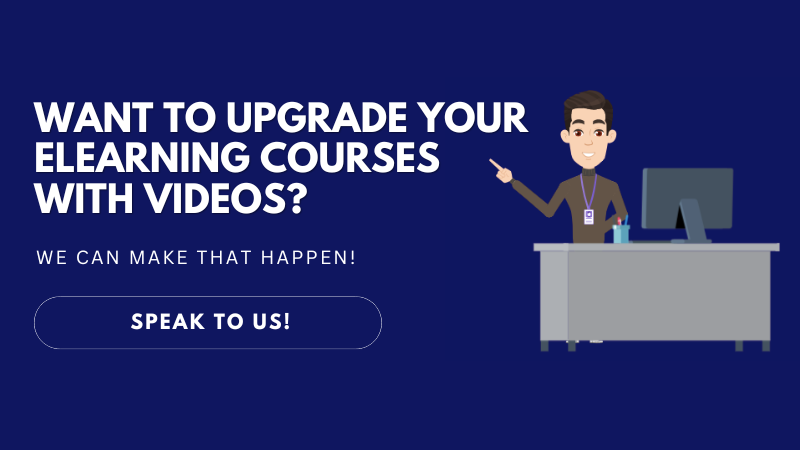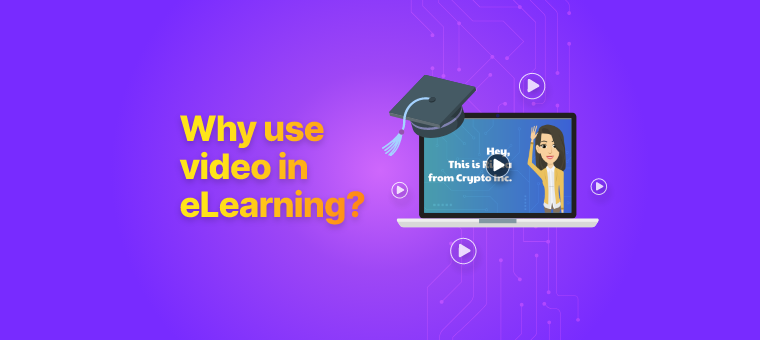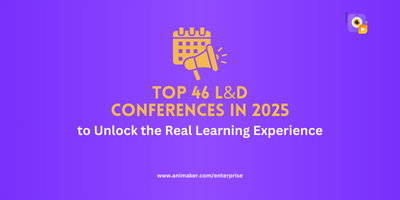Why use Video in eLearning? [Effectively Enhance eLearning Experience!]
Corporate eLearning has become an essential component of modern workforce development, providing companies with a scalable and efficient way to train their employees.
It has revolutionized corporate training by offering flexible, accessible, personalized learning experiences.
By integrating multimedia elements, eLearning enhances engagement and retention, making education more effective and enjoyable.

As technology advances, L&D teams have many opportunities to make effective eLearning content.
Video, in particular, emerges as a powerful multimedia element used within eLearning. Its ability to simplify complex topics, showcase real-world applications, and cater to visual learners makes video an engaging and effective medium for providing information.

In the current age of TikTok and Instagram Reels, and with Gen Z entering the workforce, their very limited attention spans are forcing L&D teams to find innovative ways to reach their employees.
To dive deeper and explore the importance of using video in eLearning, we will see,
- Why use video in elearning?
- Type of eLearning video styles
- Tips for creating eLearning videos
- Tools for creating eLearning videos
That being said, let’s look at the reasons why one must use video in eLearning.
Why use video in eLearning?
Video in eLearning has 4 main benefits. They are:
1. Enhanced Engagement
Video captures and maintains learners' attention by combining dynamic visuals, audio, and sometimes interactivity.
Unlike text-based content, videos can illustrate complex concepts with animations, real-world demonstrations, and engaging narratives.

This approach keeps learners interested and involved, reducing the likelihood of distraction and improving the overall learning experience.
Additionally, videos can present information in short, bite-sized chunks, thereby encouraging learners to complete the course without abandoning it midway.
2. Improved Retention
The combination of visual and auditory elements in videos helps in better understanding and memory retention.
Visuals can simplify complex information, making it easier to grasp through diagrams, charts, and animations.

Auditory elements, such as narration and sound effects, reinforce the visual content, making the information more engaging and easier to remember.
This dual-channel learning approach helps learners remember content longer and comprehend it more deeply.
3. Self-paced Learning
One of the key benefits of video in eLearning is the ability to learn anytime, anywhere.
Videos can be accessed on various devices, including smartphones, tablets, and laptops, making learning flexible and convenient.

This is particularly beneficial for employees with busy schedules or those working remotely, as it ensures they have equal access to training materials.
Videos can be paused, rewound, and replayed as needed, allowing learners to control the pace of their learning and review complex material multiple times.
Furthermore, videos can include subtitles and transcripts, making them accessible to individuals with hearing impairments or those who prefer to read along.
Nowadays, AI tools like Animaker Subtitles can generate subtitles for videos in a couple of minutes, making work easier for L&D teams.
4. Appeal to Different Learning Styles
Videos cater to different learning styles by integrating visuals and auditory elements.
Visual learners benefit from seeing information presented in a graphical format, such as animations, diagrams, and on-screen text.
Auditory learners also benefit from listening to explanations, narrations, and discussions.
Videos can include interactive elements, such as quizzes and scenario-based learning, that allow kinesthetic learners to engage actively with the content.

This approach ensures that a diverse range of learners can find a method that works best for them, enhancing their overall learning experience and outcomes.
These are a few of the benefits of using video in eLearning.
Now, let’s look at the types of eLearning videos.
Types of eLearning video styles
How-To Videos
How-to videos serve as step-by-step guides for processes and tasks, catering to the needs of different corporate teams.
These videos break down complex procedures into manageable steps, making it easier for employees to follow along and replicate the actions.
They are especially useful for onboarding new employees, training on new software, or teaching specific job-related skills.
With the ability to pause and replay sections, learners can proceed at their own pace, ensuring they fully understand each step before moving on.
Animated Explainers
Animated explainer videos use animation to simplify complex concepts, making them more digestible and engaging for learners.
These videos can illustrate concepts and data in a visually appealing and easily understandable way.
By using animated characters, graphics, and storytelling techniques, animated explainers capture attention and maintain interest throughout the course.
This increased engagement helps employees stay focused and motivated to complete the entire course.
Additionally, animations can be tailored to fit the corporate culture and branding, providing a cohesive and professional learning experience.
Whiteboard Videos
These videos feature hand-drawn illustrations on a whiteboard, typically accompanied by a voiceover explaining the concepts.
They visually break down complex ideas into simple, easy-to-understand drawings and animations, making the content engaging and memorable.
The hand-drawn style adds a personal touch, making the information more approachable and less formal.
Instructor-led videos
These videos show an instructor delivering content directly to the camera, explaining concepts, providing insights, and guiding learners through the material.
Visual aids such as slides, graphics, or demonstrations are often used to improve understanding.
Instructor-led videos are highly effective for conveying complex information, as the instructor can use gestures, tone of voice, and expressions to emphasize key points and clarify difficult concepts.
This personal touch helps create a connection with the learners, making the content more engaging and relatable.
Interactive Videos
Interactive videos engage learners with interactive elements and quizzes, transforming passive viewing into an active learning experience.
These videos often include clickable hotspots, branching scenarios, and integrated assessments that prompt learners to make decisions and test their knowledge.
By involving learners in the content, interactive videos enhance retention and understanding.
They encourage critical thinking and problem-solving skills, making the learning process more dynamic and effective.
In a corporate setting, interactive videos can be used to simulate real-life situations, allowing employees to practice and apply their skills in a risk-free environment.
These are a few of the many eLearning video styles. Now, let's look at some tips for creating effective eLearning videos.
Tips for creating eLearning videos
To ensure your eLearning videos are engaging and effective, consider the following tips:
1. Keep Videos Concise and Focused
Short, focused videos prevent information overload and help learners absorb information effectively.
Aim to keep videos between 5 to 8 minutes, focusing on a single topic or concept.

This approach makes it easier for learners to follow along and retain information, ensuring efficient and impactful learning.
2. Incorporate Storytelling
Stories can demonstrate concepts in a way that resonates with learners, helping them connect theoretical knowledge to real-world applications.

By incorporating characters, scenarios, and narratives relevant to the learners' experiences, storytelling can make complex information more understandable and engaging.
A well-crafted story can capture attention, evoke emotions, and enhance retention, making the learning experience more enjoyable and effective.
3. Use High-Quality Visuals and Audio
High-quality graphics, animations, and clear, crisp audio contribute to a polished and professional look, which helps maintain learner interest and credibility.
Avoid distracting elements like background noise or poor-quality images, as they can detract from the learning experience.

Consistent and high-quality production values signal learners that the content is valuable and worth their attention.
4. Add Interactivity
Interactive videos engage learners by prompting them to participate actively in the learning process.

Incorporate elements such as quizzes, clickable buttons, and branching scenarios that require learners to make decisions and apply their knowledge.
These features not only make the learning process more dynamic but also help reinforce understanding and retention.
Now that we have seen a few very important tips required for creating eLearning videos, let’s look at the tools for creating professional quality eLearning videos.
Tools for creating eLearning videos
When it comes to creating eLearning videos, a variety of tools are available, each offering unique features to meet different instructional needs.
Here’s a closer look at some of the best options.
1. Animation-powered eLearning videos
For animation-powered eLearning videos, use Animaker.
If you’re wondering what Animaker is, it is the World’s No.1 ranked Animation maker, enabling easy creation of professional-looking 2D animations and live-action videos.

This tool enables you to create engaging animated eLearning videos. Its user-friendly interface and rich media library of 150M+ assets make it ideal for creating fun and informative content.
Animaker also provides customizable templates and drag-and-drop functionality, allowing even beginners to create professional-quality animations effortlessly and quickly. You can also collaborate with your team to create perfect animated eLearning videos.
2. Slide-based eLearning Videos
If you prefer slide-based videos, use Canva.
Canva is an online design tool that simplifies the creation of graphics, presentations, posters, and more.

Canva provides a straightforward platform for designing visually appealing slides that are perfect for presentations.
Its wide range of templates and design elements help you create professional-looking videos with ease.
Canva includes collaborative features, allowing team members to work together in real time, and integrates with various media types to ensure your videos are dynamic and engaging.
3. Whiteboard eLearning videos
For whiteboard videos, use Videoscribe. VideoScribe is a popular whiteboard animation tool that allows users to create engaging, hand-drawn animation videos.

It offers a vast library of images, templates, and music tracks, making it easy to create whiteboard videos quickly. It provides various customization options, including text, color, and animation effects.
4. Live AI eLearning Videos
To create live AI videos, use Steve AI. Steve AI leverages AI to produce realistic live-action videos, enhancing video production capabilities with its automated features.

This tool offers multiple ways of generating videos, such as text-to-video, voice-to-video, talking head video, blog-to-video, etc.
It offers extensive customization options and a large collection of stock images and videos to meet their requirements. Its advanced AI capabilities ensure effortless, smooth, natural, and professional video production.
5. AI Animation eLearning Videos
For AI animation videos, use Animaker AI. This advanced tool utilizes AI to generate high-quality animations quickly from just a few user inputs.

Animaker AI is perfect for creating visually impressive and dynamic eLearning content without extensive effort.
It offers pre-built characters and scenes, saving time on design. The AI-driven platform continuously improves, delivering better animation results and making it an efficient choice for rapid content creation.
6. Scenario-Based, Interactive Videos
For scenario-based videos, use Articulate Storyline combined with Animaker.

We are already familiar with Animaker. Articulate Storyline, to those unfamiliar, is a course authoring tool that excels at creating interactive eLearning courses with its user-friendly interface.
To understand why Animaker should be combined with Storyline instead of just Storyline, look at this course created using Articulate Storyline.
The course offers valuable and essential information for healthcare learners, but it fails to engage the audience visually. The character is just an image in different poses, and the course is text-heavy.
So, while Articulate Storyline is fantastic for designing the overall structure and interactivity of courses, it isn't specifically designed for creating video content.
Now, let’s look at an animated course on the same topic made with Animaker and then integrated into Articulate Storyline.
Notice how engaging this course is?
Not only does this course explain the content better, but it also has animated videos on every slide with different backgrounds, properties, and animated characters.
The characters have movement and are not in static poses like the previous course.
So, to craft high-quality video courses like this one, you need specialized video creation tools, after which you can integrate them into course authoring tools.
7. Video Thumbnails
To create video thumbnails, use Picmaker.

Picmaker is an online design tool for creating stunning designs for various social media platforms.
It offers a range of templates and design options to help you create eye-catching thumbnails that attract viewers.
Picmaker offers AI-based suggestions to enhance your designs and also provides an extensive library of elements, ensuring unique and creative thumbnails.
In short, Picmaker enables the creation of professional and engaging thumbnails easily.
8. AI Voiceover for videos
When you need AI voiceovers for your videos, use Animaker Voice. Animaker Voice is an efficient AI tool that allows you to generate realistic human-like voices from text.

All that is required is to enter the text and choose the desired gender, language, and voice.
Animaker Voice offers 2000+ voice options and easy integration with your video projects.
It supports 200+ languages and accents, making it versatile for global audiences. Its intuitive interface allows quick adjustments to tone and pitch for perfect voiceovers.
9. AI Subtitles for videos
Finally, to add subtitles to your videos, use Animaker Subtitles.
Animaker Subtitles is an AI subtitle generator that can add and translate subtitles quickly!

This tool uses AI to analyze the video and add accurate synchronized subtitles. With subtitles added to your videos, you can ensure that your videos are accessible to a broader audience.
Animaker subtitles support multiple languages, so you can easily translate the AI-generated subtitles to 130+ languages.
The easy editing options allow quick corrections and adjustments, enhancing the viewing experience with very minimal effort.
These are a few tools that you can use to make eLearning videos. Explore these options to find the perfect fit for your instructional needs and enhance the eLearning experience for your audience.
***
Video is a powerful tool in eLearning. By integrating animations, interactivity, and narrative storytelling, videos can transform boring eLearning courses into immersive and effective experiences.
If you're looking to elevate your eLearning courses with high-quality videos, consider reaching out to our experts at Animaker.
Don't settle for basic training materials—transform your eLearning with the power of video today!








